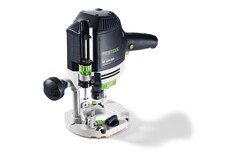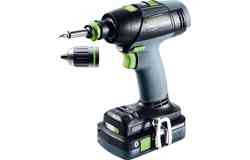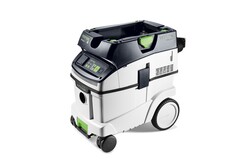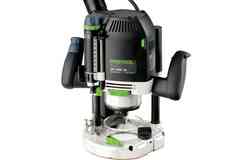Routing circles using MFS multi-routing template

Description
- Speaker boxes
- Window apertures
- Counter construction
- Basin installation
Tools/accessories
Alternative tools
Preparation/set-up
-
The largest radius that can be routed, depending upon the particular MFS, can be found from the table. In any case, the cutter diameter and the radius type to be produced must be taken into consideration. The MFS must be selected according to the radius to be produced. Alternatively, the MFS can also be expanded using the extension profiles for even larger radii.

-
Fit the multi-routing template according to the instructions and insert both the circle routing insert and centring pin.
Adjust the circle routing insert so that it can move freely along the entire length of the MFS groove. To do this, position the circle routing insert on a corner and tighten the corresponding retaining screw on the MFS. Next, push the circle routing insert into the other corner, align the MFS, tighten the corresponding retaining screw on the MFS and then check that the circle routing insert can move freely.
Adjusting the multi-routing template:- For an outer radius:
Subtract half of the cutter diameter from the radius and set this using the scale and "0" marking on the circle routing insert on the MFS, then clamp it.
Example: Outer radius 200 mm; Cutter diameter 14 mm
Set dimension: 200 mm - (14 mm/2) = 193 mm.
- For an inner radius:
Add half of the cutter diameter to the radius and set this using the scale and "0" marking on the circle insert on the MFS, then clamp it.
Example: Inner radius 200 mm; Cutter diameter 14 mm
Set dimension 200 mm + (14 mm/2) = 207 mm.
Preparing the router for routing a circle:- Fit the 30 mm diameter copying ring on the router (in the items included with the OF 1400).
- Attach dust extraction attachment and extractor hose.
- Insert the groove cutter in the router and tighten.
- Set the speed to level 6.

- For an outer radius:
Procedure
-
Drill an 8 mm diameter bore into the workpiece in the centre of the circle.
Insert the multi-routing template with circle centring mandrel into the hole in the workpiece.
Insert the router into the circle routing insert.
Set the routing depth and plunge cut.
-
Guide the multi-routing template together with the router up to the scribe mark or where the routing started (circle).
Please note the routing direction:
If the circle or groove is routed out of solid material, the router, together with the template, can be moved either clockwise or anti-clockwise.
For example, if the circle has already been coarsely cut out using the jigsaw, or if the circle needs to be re-routed, the outer radius must be routed anti-clockwise and the inner radius must be routed clockwise so that the router is guided in reverse direction.
-
Tip: When routing circle cut-outs, be aware that the centre around which the MFS is rotated is no longer securely fixed. To guarantee a secure centre position when routing circles using the router, a connection using three or four wooden supports is attached to the rear side of the workpiece. When routing through the material, these wooden supports will be slightly cut but they will nevertheless provide a secure interconnection.

-
Our illustrated guides and work results are documented working steps that we have performed in practice. They are individual examples and do not guarantee or promise that users will obtain the same results. The results will depend on the user's experience and skill, as well as the material being used. Illustrated guides do not replace any Festool operating manuals and/or safety instructions. Liability for ensuring that the information, instructions and applications are free from content defects and defects of title, in particular with regard to the absence of defects, correctness, freedom from third party intellectual property rights and copyrights, completeness and fitness for purpose, is excluded. Claims for damages made by the user, regardless of their legal basis, are excluded. These liability exclusions are not applicable if the damage was intentional or caused by gross negligence, or in cases of statutory liability.
We cannot accept liability for damage resulting from defects.↑











































